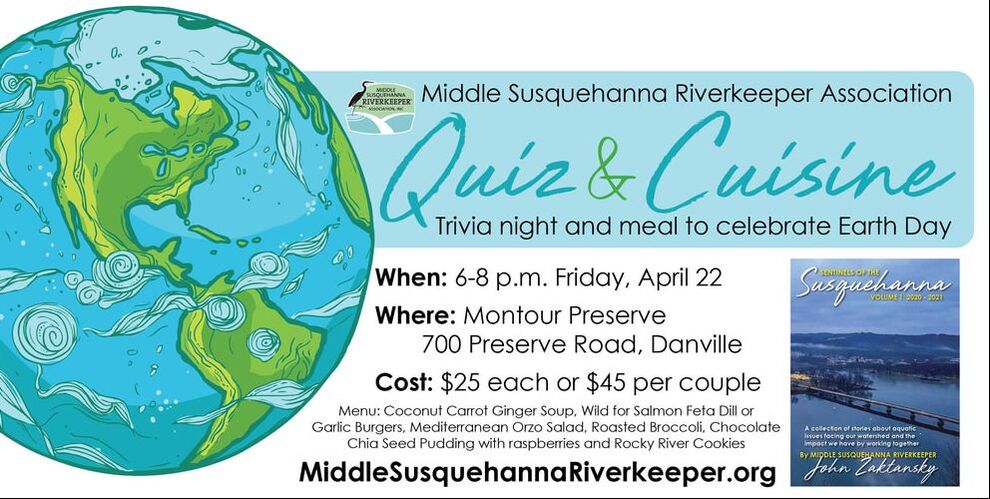|
As a fun way to raise awareness about important issues facing our river and the network of tributaries that feed into it along with celebrating the 50th anniversary of the nationwide Clean Water Act, the Middle Susquehanna Riverkeeper Association is holding a "Quiz & Cuisine" trivia night and meal on Earth Day. Scheduled to run from 6-8 p.m. on Friday, April 22, 2022, at the Montour Preserve near Washingtonville, the trivia portion will focus on questions developed from stories available on the association's blog feed, which are also in the new paperback book, "Sentinels of the Susquehanna: Volume 1," which includes more than 50 stories about a wide variety of topics related to the river and the aquatic resources that depend on it. Links to free versions of each of the stories online are below.
Earth Day 's origins go back to the environmental movement of the 1970s, helping spark the nation's Clean Water Act 50 years ago this year, along with a number of other environmental milestones. "I find it fascinating that Senator Gaylord Nelson (D, Wisconsin) started the movement by organizing 'teach-ins' on college campuses across the US," stated Kathy Snavely, a former college professor of entrepreneurship and president of the Middle Susquehanna Riverkeeper Association. "He watched the tactics used by the 70's anti-war movement, roped in partners Congressman Ed McCloskey (R, California) and grassroots activist Denis Hayes to help move the idea along, and initiated what became known as Earth Day on April 22." It is estimated that 10 percent of American citizens were engaged at some point during the first Earth Day in 1970. The event went global in 1990, organized by Hayes, giving a big boost to the recycling movement. Approximately 200 million people across the planet took part that year. "How wonderful if we could raise that kind of dedication once again?" asked Snavely. "We cannot repay Senator Gaylord, Congressman McCloskey and Denis Hayes for awakening the nation to environmental concerns. That's as clear as the water we need to be drinking." Intro: Becoming a Riverkeeper
Forward: Terms and trends to know Chapter 1: The Eastern hellbender
Chapter 2: Microplastics
Chapter 3: Fracking
Chapter 4: Invasive species
Chapter 5: Abandoned mine issues
Chapter 6: Cost of construction
Chapter 7: How fish kills are handled Chapter 8: Environmental reporting
Chapter 9: Waterway conditions
Chapter 10: Endocrine disruptors Chapter 11: Following the flows
Chapter 12: Pandemic trash trends
Chapter 13: Trees and erosion
Chapter 14: Black fly spraying Chapter 15: Vernal pools
Chapter 16: Protecting trout
Chapter 17: Birds in our watershed
Chapter 18: Rescue tips Chapter 19: Waterway safety
Chapter 20: Getting outdoors
Chapter 21: Outdoor education
Chapter 22: Engagement
Chapter 23: Lessons from Montour
In addition to stories from our book (and their online counterparts), here are a few more recent stories from which we may pull for trivia questions: Study highlights live stake success as collaborative strives to improve streams Montour Preserve land management specialist reflects on memorable moments Lake sustainability study one of several advances made since settlement agreement How winter storms, road salt and increasing salinity impact aquatic resources Fracking companies extracting gas from under river, other waterways since 2010 Catawissa Creek an example of collaboration, persistence in tackling AMD issues
0 Comments
Leave a Reply. |
AuthorsRiverkeeper John Zaktansky is an award-winning journalist and avid promoter of the outdoors who loves camping, kayaking, fishing and hunting with the family. Archives
July 2024
Topics |



 RSS Feed
RSS Feed